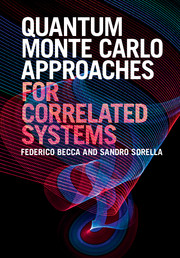Book contents
- Frontmatter
- Contents
- Preface
- Acknowledgements
- Part I Introduction
- Part II Probability and Sampling
- 2 Probability Theory
- 3 Monte Carlo Sampling and Markov Chains
- 4 Langevin Molecular Dynamics
- Part III Variational Monte Carlo
- Part IV Projection Techniques
- Part V Advanced Topics
- Appendix Pseudo-Random Numbers Generated by Computers
- References
- Index
3 - Monte Carlo Sampling and Markov Chains
from Part II - Probability and Sampling
Published online by Cambridge University Press: 17 November 2017
- Frontmatter
- Contents
- Preface
- Acknowledgements
- Part I Introduction
- Part II Probability and Sampling
- 2 Probability Theory
- 3 Monte Carlo Sampling and Markov Chains
- 4 Langevin Molecular Dynamics
- Part III Variational Monte Carlo
- Part IV Projection Techniques
- Part V Advanced Topics
- Appendix Pseudo-Random Numbers Generated by Computers
- References
- Index
Summary
Introduction
Monte Carlo methods indicate a broad class of numerical algorithms that are based upon repeated random sampling to obtain the solution of several mathematical and physical problems. The typical issue is about the calculation of large sums or integrals and the revolutionary idea is that we do not perform an exact enumeration/ integration but instead we generate random samples, which are then added together to approximate the exact result. Therefore, the concept of sampling is pivotal in any Monte Carlo approach: its meaning is just to produce random examples of configurations (e.g., N classical particles distributed in a box) that are used to give an accurate estimate of the exact quantity under examination (e.g., the internal energy at fixed temperature).
The roots of the Monte Carlo approaches date back to Enrico Fermi's attempts while studying neutron diffusion in the early thirties. He did not publish anything on the subject, but he got the credits for the idea that a time-independent Schrodinger equation can be interpreted in terms of a system of particles performing a random walk (Metropolis and Ulam, 1949). Few years after, a fundamental step forward has been done by Stanislaw Ulam, when he was working on nuclear-weapon projects at the Los Alamos National Laboratory. His first thoughts about Monte Carlo methods were suggested by a question that occurred when he was convalescing from an illness and playing solitaire. Ulam tried to calculate the likelihood of winning based on the initial layout of the cards. After exhaustive combinatorial calculations, he decided to go for a more practical approach of trying out many different layouts and observing the number of successful games. At that time, a new era of fast computers was beginning and John von Neumann understood the relevance of Ulam's suggestion and proposed a statistical approach to solve the problem of neutron diffusion in a fissionablematerial. Ulam and von Neumann worked together to develop algorithms including importance sampling and rejection sampling, which are at the basis of any modern Monte Carlo technique. In addition, von Neumann developed a way to obtain pseudo-random numbers by using the so-called middle-square digit method, since he realized that using a truly random number was extremely slow.
- Type
- Chapter
- Information
- Quantum Monte Carlo Approaches for Correlated Systems , pp. 56 - 84Publisher: Cambridge University PressPrint publication year: 2017
- 1
- Cited by



